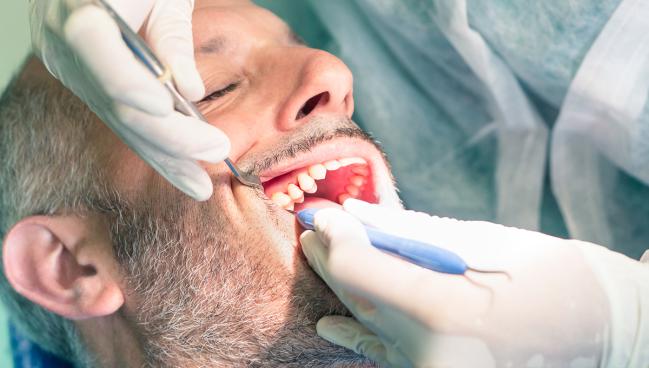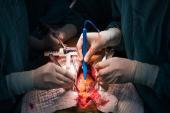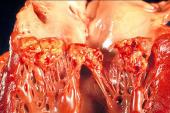Antibiotics Before Invasive Dental Work Helpful in High-Risk Patients
“These patients are shared between cardiologists and [their] dentists, so both parties need to play a role,” a researcher says.

Prophylactic antibiotics, when given to high-risk patients before they have invasive dental procedures, are linked to a lower likelihood of infective endocarditis (IE) in the month thereafter, according to an observational study that looked at nearly 4,800 IE cases.
For decades, antibiotic therapy was used to address the potential for IE in patients undergoing invasive dental procedures. But in quick sequence starting 15 years ago, three new guidelines arrived on the scene. In 2007, the American Heart Association (AHA) narrowed the target for prophylaxis to only high-risk patients. In 2008, the UK’s National Institute for Health and Care Excellence went in a different direction, recommending against antibiotics irrespective of risk. The European Society of Cardiology followed, in 2009, by issuing advice in line with the AHA’s.
The new findings, published online this week in the Journal of the American College of Cardiology, provide the strongest evidence yet supporting the AHA’s and ESC’s emphasis on prevention in the high-risk subgroup of patients, researchers say.
“Our data validates that recommendation,” lead author Martin H. Thornhill, MBBS, BDS, PhD (University of Sheffield, England, and Carolinas Medical Center–Atrium Health, Charlotte, NC), told TCTMD. Previously, “the problem has been although these guidelines exist, there really hasn’t been any hard evidence to support the guidance, neither in terms of there being a clear association between invasive dental procedures and endocarditis, nor in terms of the efficacy of antibiotic prophylaxis.”
Given that a randomized controlled trial in this area would be unethical and costly, said Thornhill, an observational analysis such as this may be the best evidence available. He said he hopes it is sufficient to sway practice—just one-third of high-risk patients in the data set received antibiotic prophylaxis prior to their procedures. “Clearly, there’s a large amount of room for improvement.”
Better communication among clinicians, greater awareness among patients, and tools like automatic reminders within electronic health records could help, he suggested. “These patients are shared between cardiologists and [their] dentists, so both parties need to play a role in encouraging their patients about oral hygiene and ensuring that those that are at high risk receive the appropriate antibiotic prophylaxis when it’s needed.”
With Antibiotics, IE Risk Is Halved
Thornhill and colleagues analyzed data for 7,951,972 US patients who had employer-provided commercial insurance/Medicare supplemental coverage between 2000 and mid-2015. Among them, 3,774 were hospitalized with IE, amounting to 475 cases per million individuals.
Around one-third of those hospitalized (34.2%) were at high IE risk due to having a previous history of IE, prosthetic cardiac valve, prosthetic material used for valve repair, unrepaired cyanotic congenital heart disease, or palliative shunt/conduit to treat congenital heart disease, or because they’d undergone repair of a congenital heart defect using prosthetic material within the past 6 months. The remaining 22.0% of patients were at moderate risk (due to rheumatic heart disease, nonrheumatic valve disease, congenital valve anomalies, or hypertrophic cardiomyopathy), and 43.8% at low/unknown risk. For the three groups, the adjusted IE incidence within 30 days of a dental procedure was 467.6, 24.2, and 3.8 per million procedures.
The problem has been although these guidelines exist, there really hasn’t been any hard evidence to support the guidance. Martin H. Thornhill
Most IE occurred within 4 weeks. In a case-crossover analysis, wherein each participant served as their own control, high-risk patients were more likely to experience IE if they’d had an invasive dental procedure in the prior 4 weeks (OR 2.00; 95% CI 1.59-2.52). Risk was most elevated following dental extractions (OR 11.08; 95% CI 7.34-16.74) and oral surgery (OR 50.77; 95% CI 20.79-123.98). Patients who underwent scaling, however, were at lower risk in the weeks following their procedure (OR 0.69; 95% CI 0.47-1.02). For those at moderate risk, there were no links between any of the dental procedures and subsequent IE risk.
The link between scaling and fewer IE cases in high-risk patients was unexpected, the paper notes, “because scaling is invasive and causes equivalent bacteremia to extractions.” Thornhill suggested a possible explanation is that “probably people who have their teeth scaled regularly are likely to have good oral hygiene, which may be protective from them getting endocarditis.”
Antibiotic prophylaxis was prescribed for 32.6%, 9.5%, and 2.9% of patients with high, moderate, and low/unknown risk, respectively.
High-risk patients given antibiotics prior to their dental procedures were at lower risk of developing IE in the next 30 days (OR 0.49; 95% CI 0.29-0.85), with stronger associations seen after extractions (OR 0.15; 95% CI 0.04-0.55) and, though not significant, after surgery (OR 0.08; 95% CI 0.01-1.13). For moderate-risk patients, antibiotics were linked to a reduction in IE after dental procedures overall (OR 0.34; 95% CI 0.14-0.88), but not when analyzed separately by procedure type. A cohort analysis confirmed these associations in the high-risk group, but showed no link between antibiotics and IE in the moderate-risk group.
In an editorial, Ann Bolger, MD (University of California, San Francisco), and Dhruv S. Kazi, MD (Harvard Medical School, Boston, MA), caution that the analysis, though it addresses a key clinical and public health question, has several limitations. The number of included hospitalizations represents a small slice of the more than 50,000 IE hospitalizations each year in the United States, the population includes adults with employer-provided insurance only, and the study period excludes the past 7 years, “a time when antibiotic-prophylaxis practices and IE epidemiology were evolving rapidly,” they write.
Additional studies are needed to confirm these findings, Bolger and Kazi say, suggesting several potential avenues for research. “Regardless of the approach chosen, we must continue to seek population-specific and representative information to inform antibiotic-prophylaxis recommendations given the wide variation in risk of IE, bacteriology, and health systems among and within countries,” they advise, adding, “Provision of antibiotic prophylaxis according to current recommendations may offer tangible benefits to high-risk patients today, even as we anticipate increasingly refined and evidence-informed guidelines in the future.”
Caitlin E. Cox is News Editor of TCTMD and Associate Director, Editorial Content at the Cardiovascular Research Foundation. She produces the…
Read Full BioSources
Thornhill MH, Gibson TB, Yoon F, et al. Antibiotic prophylaxis against infective endocarditis before invasive dental procedures. J Am Coll Cardiol. 2022;Epub ahead of print.
Bolger A, Kazi DS. Antibiotic prophylaxis against endocarditis prior to invasive dental procedures: filling in the gaps. J Am Coll Cardiol. 2022;Epub ahead of print.
Disclosures
- The study was funded by a research grant from the Delta Dental of Michigan Research Committee and Renaissance Health Service Corporation.
- Thornhill received support from the Delta Dental Research and Data Institute for this work.
- Bolger has received royalty payments (section editor duties) from UpToDate, participated in the 2007 and 2021 AHA statements on antibiotic prophylaxis to prevent infective endocarditis, and served as a member of the AHA Committee on Rheumatic Fever, Endocarditis, and Kawasaki Disease.
- Kazi participated in the 2021 AHA statement on antibiotic prophylaxis to prevent infective endocarditis; and has served as a member of the AHA Committee on Rheumatic Fever, Endocarditis, and Kawasaki Disease.





Comments